Bayer R.G. Mechanical Wear Fundamentals and Testing, Revised and Expanded
Подождите немного. Документ загружается.


the specimens once they are prepared are given, as are procedures for applyi ng the load
and bringing the ring up to speed. The user is also instructed to examine the shape and
morphology of the wear scar on the block, pointing out features that should be
observed and what actions should be taken if they are found. For example, micrographs
inFig.9.22
show the effect of misalignment between block and ring, as well as an
out-of-flatness condition on the block. When these conditions occur, the test should
be rerun.
Also, evident in one of the micrographs (Fig. 9.22b) is an example of the effect that
galling and plastic deformation may have on the appearance of the wear scar. This type of
phenomena is a frequent characteristic of this test, particularly when a lubricant is not
used and for certain types of materials and material pairs. These phenomena can distort
the definition of the edges of the wear groove. When this distortion is smal l or moderate,
as is shown in the micrograph, it is possible to estimate the true edge with sufficient accu-
racy for a valid test. Sometimes the distortion is so severe that this cannot be done, and a
milder form of the test should be considered for evaluating the materials. This might
involve using a lighter load, slower speed, and shorter duration. Even if this type of phe-
nomena does not prevent accurate measurement of the edges, their significance in terms of
simulation should be considered. If such phenomena are not relevant to the application,
the test conditions should be modified to achieve better simulation. As a rule of thumb,
the more ‘‘wear resistant’’ the category of the materials tested, the higher the loads and
speeds that can be used without experiencing these types of phenomena. For example,
higher loads and speeds can be used when ceramics or hardened steels are being evaluated,
than when plastics or softer alloys are tested.
An extensive amount of information and data should be recorded and measured
with respect to the test. The list of data that the standard recommends be reported with
thetestisshowninFig.9.23
. This includes friction data. Comparison of friction behavior
in repeated tests can be an indicator of the amount control in the test, as has been
discussed.
While the test method allows the investigator to select parameters to best simulate
the application, there are some features that potentially limit the degree of simulation that
can be achieved. Since the block experiences significantly more rubbing than the ring, the
test is limited in term s of its ability to simulate the relative amount of wear between the
pair of materials. It is also a unidirectional test. The test also is one in which the contact
pressure varies through the test. Initially, the contact can be described as a Hertzian line
contact. Small contact area, high stress and significant subsurface stresses characterize this
type of contact. Once a wear groove is formed in the block, it becomes a conforming
Figure 9.22 Black wear scars—conditions found in the block-on-ring test. ‘‘a’’ shows an ideal scar.
‘‘b’’ shows a scar with nonuniform edges as a result of galling and deformation. ‘‘c’’ shows the
condition associated with crowned specimens and ‘‘d’’, misaligned specimens. (From Ref. 119,
reprinted with permission from ASTM.)
Copyright 2004 by Marcel Dekker, Inc. All Rights Reserved.

contact. With this ch ange, the stress system changes and the overall stress level decreases.
As the wear increases, the area of contact continues to increase and the stress level
continues to reduce. Since stress can influence wear, this characteristic can limit the degree
of simulation that can be obtained with this test. For example, this aspect of the test could
be a factor in the degree of correlation that can be obtained with conforming contact
applications, such as with thrust bearing s.
Because of this aspect, wear rate tends to change its wear progresses with the result
that a wear curve for this test configuration tend to be generally nonlinear. This results in
the requirement that a single test duration be used for comparing materials. While this
approach to the problem of nonlinear behavior has been found to be effective in material
rankings with this test, it is not the only approach or the most complete approach that
Figure 9.23 A format for reporting block-on-ring test data.
Copyright 2004 by Marcel Dekker, Inc. All Rights Reserved.
can be taken. An exposure that is associated with this approach is that if the nonlinear
behavior or relationship varies with material pairs (24), it is possible to obtain different
rankings with different test duration. This is because the wear curves can cross
(Fig.8.7).
An alternate approach would be to develop a wear curve and base comparison
on this, such as done in the standard liquid cavitation test. Since wear rates tend to become
stable or quasistable (slowly decreasing) in this test, another approach is to use long-term
wear rate, such as done described in Sec. 9.2.16.
To address this concern an d other limitations, varia tions in the test procedure and
parameters may be necessary. In such cases, the practices of the standard test can be
used as guides as to what to control, how to insure a valid test, etc. For the nonlinear
relationship problem, tests for two different durations can be performed to insure that
the same type of relationship occurs for the different pairs. To better characterize the
wear beh avior of a pair of materials, tests interchanging block-and-ring materials can
be performed. The tester can also be modified to provide oscillatory motion of the
ring and thereby to provide better simulation to applications which are not unidirec-
tional or which have different relative amounts of rubbing than that provided by the
standard test.
As with several of the other tests the block-on-ring test may provide a ranking of
materials for an application, but it does not provide an absolute measure of the wear
performance in that application. Also, with the block-on -ring test, the relative separation
in the rankings obtained in the test and in the field may not be the same. For exampl e,
a relatively large difference in performance in the test, perhaps a factor of two times,
could be much less in the application (e.g., only 10% or 20%). Conversely, a relatively
small difference in the test could correlate to a very large change in performance in the
application. This lack of correlation is because of the nonlinear nature of the wear behavior
that tends to be characteristic of this test. Finally, changing the test parameters can
influence this type of correlation between the test and application.
9.2.7. Crossed-Cylinder Wear Test
This is a test that has been used to rank material pairs in terms of their resistance to sliding
wear. It has been used for a number of years in industry, principally to evaluate tool steels
and hard-surfacing alloys. Procedures and parameters used by the different laboratories
tend to vary although a standard practice has been developed and issued as ASTM G83
forthistypeoftest.ThebasicconfigurationofthetestisshowninFig.9.24
. One cylinder
is held stationary and the other is pressed against it and rotated. The basic concept is
to rank materials in terms of the wear produced after a fixed number of revolutions. Wear
is directly measured by a mass loss technique but converted to volume loss for comparison.
Studies, which used the standard practice, have shown that the coefficient of variation
for intralaboratory test is within 15%, and for interlaboratory tests, 30%.
Unlike the block-on-ring procedure, which allows considerable flexibility in terms of
test parameters and materials evaluated, the standard test method for the crossed-cylinder
test is specific in terms of test parameters a nd limited in terms of the material s for which it
can be used. The test is designed for unlubricated evaluations of metals but other materials
are allowed, if they are sufficiently strong and stiff so that the specimens do not deform,
fracture, or significantly bend under the load conditions specified. In general, this would
exclude polymers. The standard test method has three procedures, which differ in terms
of speed and duration to address different levels of wear behavior. Procedure A is the most
severe test and is recommended for the most wear resistant materials. Procedure B is a
Copyright 2004 by Marcel Dekker, Inc. All Rights Reserved.
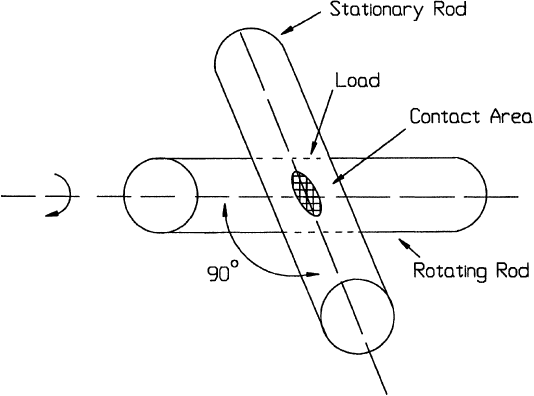
shorter version of A, whi ch can be used for less wear resistant mate rials that exhibit
sufficient wear in the shorter period of time. Procedure C is a milder test (i.e., lower speed),
that is run for a fewer number of revolutions. This was developed for the evaluation of
materials that exhibited such severe wear under the conditions of A or B that valid or
useful comparisons could not be made. This could be because of excessive heating under
the more severe conditions, extensive galling or adhesion, which would influence the accu-
racy of the measurement technique, or complete wear-through of surface treatment layers.
The selection of which procedure to use therefore depends considerably on the nature of the
materials and associated wear behavior. It is possible that more than one procedure might
be acceptable; however, the ranking and comparison of materials should be con fined to
within one test procedure. Inferring the relative behavior of materials in one test procedure,
based on relative behavior in another, should not be done for several reasons. For example,
using results from pr ocedure C with results from either of the other procedures to establish
a ranking should not be done, since the test conditions are different and their effect on
material behavior is generally not known. Also, since the nature of the wear curves in this
type of test tends to be of a variable, nonlinear nature, cross-comparison between proce-
dures A and B may not be valid, even though load and speed conditions are the same.
This test method does not provide much flexibility in terms of providi ng simula-
tion since there are only two speeds allowed. Basically the test simulates high-speed,
dry sliding wear. The user of the test has to decide first of all whether or not the appli-
cation can be described in those same gene ral terms. If the answer is yes, the test pro-
vides first-order simulation. Second-order simulation would depend on the similarity of
the standard test parameters and those of the application and the sensitivity of the
materials to any differences in those parameters. Because of the unique geometry of
the test, which is complicated by the wear of both cylinders, it is generally not possible
to make an a priori judgement regarding second-order simulation. Therefore, compar-
ison of wear scar morphology from the test with that from the application is one
way of deciding on the degree of simulation and the likelihood of good correlation
between the test and application. Similarity in the appearances generally implies that
Figure 9.24 Diagram of the crossed-cylinder test.
Copyright 2004 by Marcel Dekker, Inc. All Rights Reserved.
there should be correlation, even though there might be differences in specific values of
the parameters.
The primary intention of the test is to characterize the wear resistance of self-mated
pairs. In this case, the total volume of wear (i.e., the sum of the wear volumes obtained
from the stationary and rotating member) is used as the measure of wear resistance.
The test method allows testing with dissimilar metals as well, in this case the wear volume
for both specimens shou ld be reported separately. In addition, the method requires two
tests with the dissimilar couple, with the position of the materials interchanged in each test.
The sum of the wear volume obtained as the stationary and rotating specimen is reported
and can be used to compare with self-mated behavior.
In addition to the quantitative measurement of wear, the test procedure requires that
the worn specimens be examined for features that might make the test invalid, such as
evidence of transfer, deformation, or distortion. If any of these occur to a significant level,
the test is to be considered invalid and the test should not be used to evaluate the wear
resistance of those materials.
Specimen preparation, cleaning, measurement procedure, as well as dimensions
and tolerances of critical elements of the apparatus, are covered in the ASTM standard.
In the block-on-ring test, a key element is the alignment of the block in the axial direc-
tion of the ring and considerable details as to how to insure proper alignment are pro-
vided in that standard. In the crossed cylinder wear test, however, the alignment
criteria is not as critical, since it is a point contact but concentricity and run-out are
major factors. Consequently, the test method provides considerable detail and com-
ments regarding the needed tolerances and recommends specific chuck designs. It also
identifies a qualification test and acceptance criterion to insure adequate performance
and procedures.
There are several elements in this test that are similar to those in the block-on-
ring test. One feature is that in both tests, the stress level decreases with duration and
wear. A second feature is that the wear curves associated with both of these tests tend
to be nonlinear and of a varying nature. A third similarity is that both involve the
wear of two surfaces or bodies. To address the first two elements, both test methods
employ the same general approach (i.e., using fixed numbers of revolutions to rank
materials). Consequently, the general problems discussed regarding the extrapolation
of block-on-ring test results to absolute performance in an application are the same
for the crossed-cylinder test. The limited range of test parameters and the use of total
wear to characterize the material couple further complicate the situation with the
crossed-cylinder test. The more dissimilar the test and application conditions are,
the less likely that relative rankings will be applicable. When there is only first-order
simulation, only large differences in test results should be considered significant.
Another interesting observation with both of these tests is that the scatter asso-
ciated with interlaboratory results are noticeably higher that with intralaboratory tests.
This suggests a bias between laboratories with respect to the test but not lack of control.
Such a bias could be attributed to slight but consistent variations in procedures or am-
bient environments. Slight variations in the testing apparatus (e.g., in design and constru-
ction, alignment, load control, and vibration) also can be factors. Assuming this is the
major factor, the studies done in terms of these two tests suggest that these types of
machine variations can cause 10–15% scatter in sliding wear behavior. Of course much
larger variation can result with poorly designed and built apparatuses. This in turn
emphasizes the need for proper design and construction of wear apparatuses if minimal
scatter is to be achieved.
Copyright 2004 by Marcel Dekker, Inc. All Rights Reserved.

9.2.8. Pin-on-Disk Wear Test
This is another configuration that has been used extensively to study wear and to rank
materials. It is viewed as a general test that can be used to evaluate the sliding wear
behavior of material pairs. Its correlation wi th an application depends on the degree
of simulation that the test parameters have with those of the application. The basic con-
figurationisshowninFig.9.25
. A radius-tipped or flat-ended pin is pressed against a
flat disk. The relative motion between the two is such that a circumferential wear path
on the disk surface is generated. Either the pin or the disk can be moving. The test para-
meters that have been used with this test vary. The ASTM standard for this test, ASTM
G99, which does specify the use of a rounded pin, does not specify specific values for the
parameters, but allows those to be selected by the user to provide simulation of an appli-
cation. The parameters that can vary include size and shape of the pin, load, speed, and
material pairs. The test can also be done in a controlled atmosphere and with lubrica-
tion. Like the block-on-ring and crossed-cylinder tests, stress levels in the rounded pin
version of this type of test change during the course of the test as a result of the wear.
Consequently, the relationship between wear and duration or amount of sliding tends to
be nonlinear. For material ranking and comparison, the ASTM standard recommends
measuring the wear on both members after a fixed number of revolutions. It is also
recommended that with dissimilar pairs of materials that two test s be performed with
the materials changing positions in the test. The standard allows the use of wear curves
for comparison. This is particularly useful if nonlinear behavior is to be taken into
account. When this approach is used it specifies that new specimens are to be used
for each data point on the curve. The test should not be stopped for intermediate wear
measurements and restarted because of potential problems with alignment, disturbance
of debris and surface films, and introduction of contamination.
With flat-ended pins, an additional con cern is initial alignment. In such a case, it is
necessary to allow the specimens to wear-in (so that uniform contact is achieved) before
usefuldatacanbeobtained.ThisisillustratedinFig.9.26
. The block-on-ring test has
a similar problem associated with alignment in the axial direction of the disk. With this
type of pin, the duration has to be long enough so that the wear-in wear is negligible
Figure 9.25 Diagram of pin-on-disk test and cross-sections of pin shapes used with this type of
test. With curved surfaces wear is generally confined to the curved region.
Copyright 2004 by Marcel Dekker, Inc. All Rights Reserved.
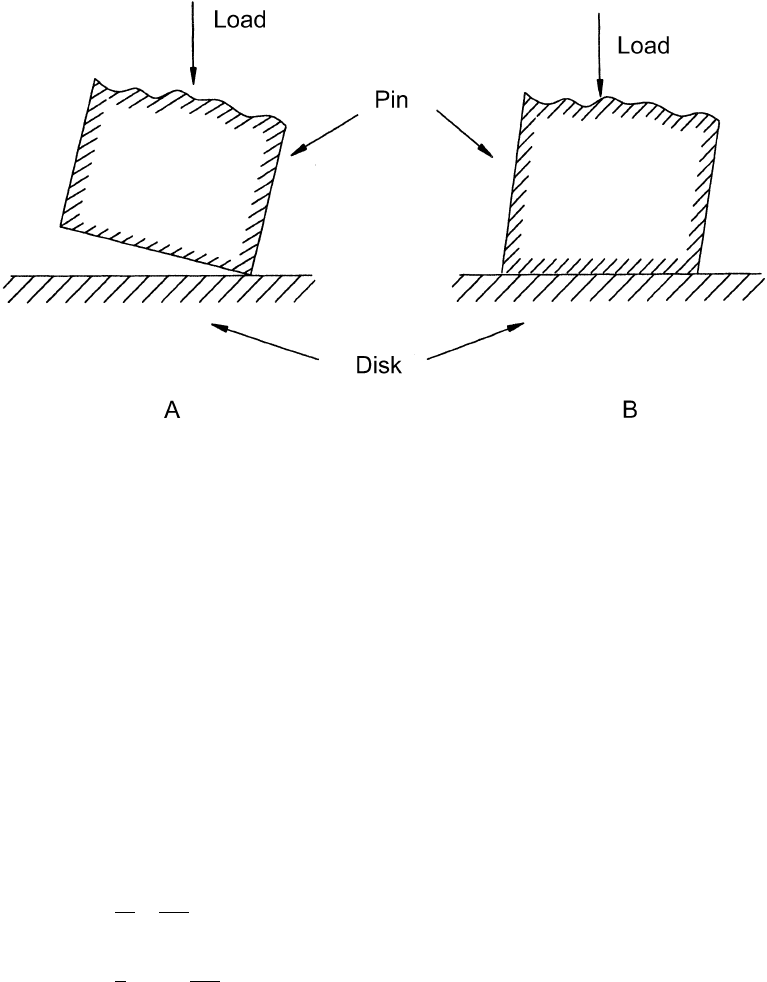
in comparison to the final wear, if final wear volume is to be used as the measure of wear
resistance. An alternative approach is to use wear rate in which case the test has to be long
enough so that a stable wear rate is obtained. Because it eliminates the alignment problem,
a rounded pin is the preferred configuration. With a rounded pin useful wear data can be
obtained after small amounts of sliding and thereby provide a continuous curve. If the
pin is flat-ended, this would not be possible since the initial portion of the wear curve
would be strongly influenced by the misalignment between the pin and the disk.
The ASTM test method allows both geometrical and mass loss methods for deter-
mining wear but in either case the measurement sho uld be converted to volume loss for
reporting. With mass loss, this is to be done by dividing the mass loss by the density. With
the geometrical approach, this is done by converting a measured linear dimension, to a
volume using the appropriate relationship for the geometry of the wear scar. For example,
in the case of negligible wear on one member and a spherical-ended pin, the width of
the wear scar can be used to compute the volume by means of the following equations:
V ¼
p
64
W
4
R
pin wear ð9:3Þ
V ¼
p
6
D
W
3
R
disk wear ð9:4Þ
where V is the volume of wear; W is the width of the flat on the pin or the width of the
wear track on the disk; D is the radius of the wear track; R is the spherical radius of
the pin. In both cases, the wear scar is either the volume of a spherical cap of cord W
(pin wear) or a groove whose profile is a circular section of cord W (disk wear). This is
showninFig.9.27
. For situations in which there is wear on both surfaces or in which
the radius end of the pin is not spherical, similar relationships have to be identified or
Figure 9.26 Misalignment in the pin-on-disk test when a flat pin is used. ‘‘A’’, initial; ‘‘B’’, after
wear-in.
Copyright 2004 by Marcel Dekker, Inc. All Rights Reserved.
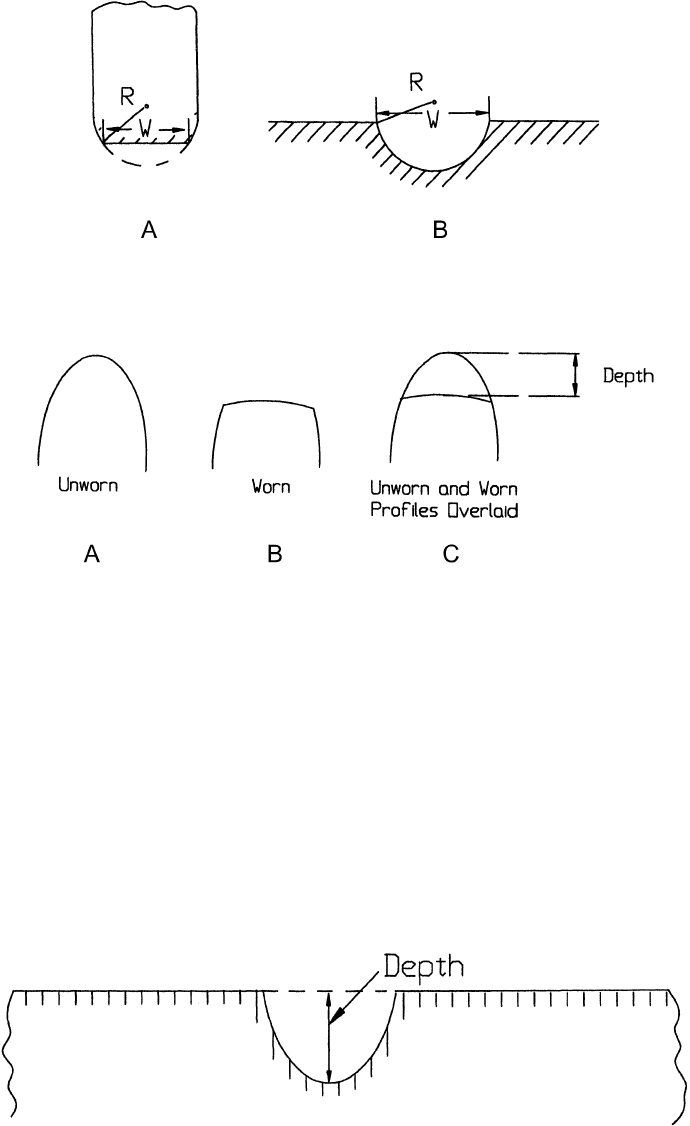
developed. In these cases, wear depth rather than width might be the best direct measure-
ment of wear. For the pin, profilometer traces be fore and after wear can be used to deter-
minedepthbymeansofanoverlaytechniqueillustratedinFig.9.28
. For the disk,
aprofilometertraceacrossthewearscarcanbeused.ThisisshowninFig.9.29
. Once
this is done, appropriate geometrical relationships or numerical methods can be used to
determine wear volumes (37,112). More examples of this geometrical approach can be
found in the design and problem solving examples in EDW2E.
While this geometrical techni que is more complex than the mass loss technique, it is
often a more sensitive technique when small amounts of wear are involved, as may occur
Figure 9.29 Determination of disk wear scar depth from a profilometer trace.
Figure 9.27 Wear scar cross-sections in the pin-on-disk test with a spherical-ended pin. ‘‘A’’ shows
the situation when there is a negligible wear on the disk; ‘‘B’’, negligible wear on the pin.
Figure 9.28 Overlay technique to determine pin wear depth when there is significant wear on the
disk. ‘‘A’’ is the profilometer trace over the center of the spherical surface before the test; ‘‘B’’, the
trace over the same location after the test. ‘‘C’’ shows ‘‘A’’ and ‘‘B’’ overlaid to determine the depth.
Copyright 2004 by Marcel Dekker, Inc. All Rights Reserved.
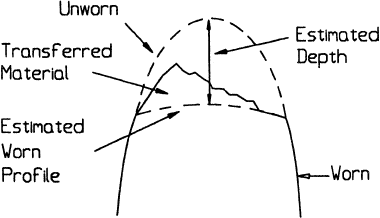
in this test. Also in this test, as well as in the two previous ones for sliding wear, transfer
can occur to such a degree that ability to accurately measure the wear is greatly decreased.
Sometimes transfer is so great that the test is an invalid method for ranking materials.
With proper interpretation of profile measurements, however, it is sometimes possible
to distinguish build- up from wear so that a valid result can be obtained. An example of
suchaninterpretationisshowninFig.9.30
.
The ASTM standard method addresses specimen prep aration, cleaning, tolerances,
loading, and measurement techniques. It also requires that the wear volumes of both mem-
bers, test conditions, a complete description of the materials involved, and the preparation
and cleaning procedures used should be reported. Test parameters should include load,
speed, temperature, roughn ess, dimensions, and shapes. It also recommends that the
coefficient of friction be measured in these tests and that these values be reported. Initial
and final values for the coefficient of friction should be given and any significant changes
during the test should be noted.
The test method also provides specific cautions. For example, it is pointed out that
while the test can be performed with the disk either horizontal or vertical, the results can
be different. The reason for this is that in the vertical pos ition wear debris can be removed
from the system by gravity, while in the horizontal posit ion it cannot. It also ad vises
against the use of wear measurements made with continuously monitoring transducers.
Transfer films, wear debris, and thermal effects can influence such measurements, and,
as a result, be erroneous. The method, per se, does not specify either the magnitude or
the method of loading, but it is pointed out that the method of loading can be a factor
in the wear. For example, differences have been observed between tests that have used a
dead weight loading method and those which have used a pneumatic method. This is
attributed to differences in the stiffness associated with these approaches and the presence
or absence of significant vibrations.
Interlaboratory test programs have been conducted for this test method. These stu-
dies have shown that when the procedures and techniques of the standard are followed
intralaboratory tests should be repeatable within 20%. If tests do not repeat within that,
it is recommended that some investigation should be done to determine the reason for the
increased scatter. Possibilities are apparatus problems, poor discipline in performing
the test, or variations associated with the materials used. Interlaboratory variation is of
the order of 40%. Both of these variations are similar to those associated with the
previously discussed tests for sliding wear. This difference in the coefficient of variation
between intra- and interlaboratory implies that machine-to-machine differences can
contribute significantly to wear behavior.
Figure 9.30 Illustration of a technique to estimate wear depth when transferred material is present.
Copyright 2004 by Marcel Dekker, Inc. All Rights Reserved.
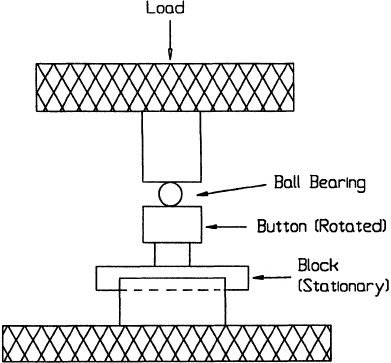
Correlation with an application is dependent on the simulation associated with the
test parameters. The usual techniques for addressing simulation need to be pursued
(e.g., comparison of wear scar morphology, selection of loads and speeds, etc.).
Acceleration can be associated with this type of test as well and the actual degree depends
on the relative values of the parameters. However, very little acceleration may be asso-
ciated with test conditions that provide good simulation. Any attempts to provide
acceleration should be investigated carefully.
9.2.9. Test for Galling Resistance
Galling is a severe form of wear characterized by macroscopic material transfer and
removal or formation of surface protrusions. It generally occurs in sliding systems, which
move slowly or intermittently and are either poorly lubricated or not lubricated. Seals,
valves, and threaded comp onents are examples of app lications, which often exhibit this
type of wear. However, it can also occur in gears and bearings under heavy loads. ASTM
G98 is a standard test method for ranking material pairs in terms of their resistance to
galling. It is an accelerated test in that the conditions of the test were selected to promote
galling and not to provide a simulation of an application. Generally, the rankings
that have been obtained with this test have been found to be useful guides in selecting
material pair for applications, which are prone to galling (25,26).
ThebasictestconfigurationisshowninFig.9.31
. It consists of a flat-ended cylinder
pressed against a flat surface. The test is performed by slowing rotating the cylinder
through 360
and then separating the two members. The surfaces are visually examined
for evidence of gall ing. If there is none, the test is repeated with new surfaces at a higher
load. If there is evidence of galling, the test is repeated at a lower load. This procedure is
followed until two load levels bracket the occurrence of galling and the load midway
between the two is used to calculate what is called the threshold galling stress. This is used
to rank the material pairs. The higher the stress, the more galling resistant the pair.
The size, flatness, and roughness of the specimens and maximum load intervals are
specified. The speed of rotation in the test is controlled by specifying the duration of the
rotation. The method allows the use of any apparatus that can maintain a constant load to
Figure 9.31 Configuration of the test for galling.
Copyright 2004 by Marcel Dekker, Inc. All Rights Reserved.
